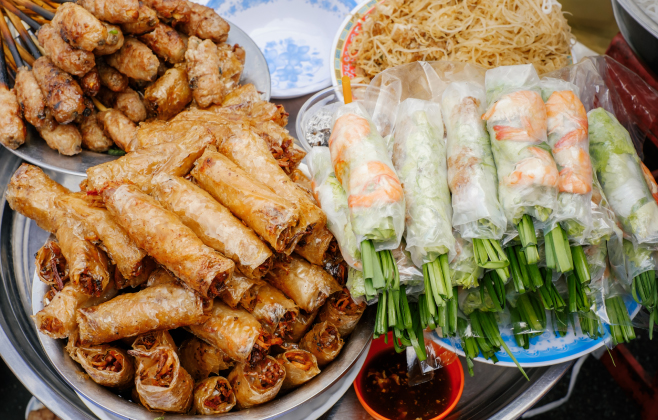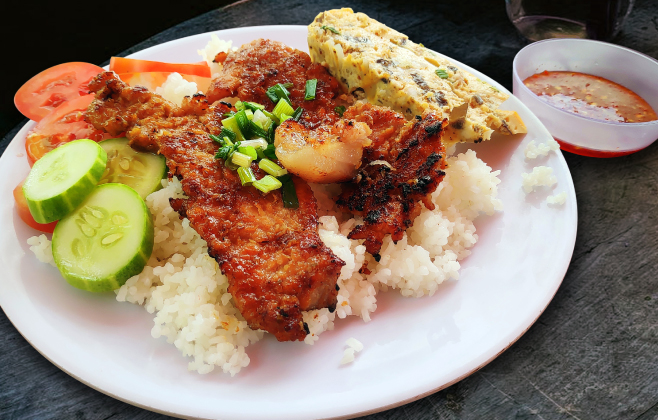How Regional Diversity Shapes The Vietnamese Cuisine Flavors
Vietnamese cuisine is an intriguing and delectable culinary practice that showcases the nation's diverse regional cultures and historical influences. Vietnamese cuisine is truly one-of-a-kind thanks to the distinct flavors, ingredients and cooking methods that each area of the country has contributed, from the highlands in the north to the tropical south. China, Cambodia, Thailand and neighboring nations, as well as the nation's colonial past, have all left their mark on Vietnamese cuisine, which is a masterful fusion of these inspirations. A meal that is both intricate and delicious is the end product.
In this article, we invite you to join us on a journey through the regional cuisines of Vietnam. We'll explore the distinct characteristics of Northern, Central and Southern Vietnamese food, highlighting the unique flavors and dishes that make each region's cuisine so special. We'll also take a closer look at the street food scene and the delightful desserts that are a staple of Vietnamese dish. Whether you're a seasoned foodie or just getting started with the nation’s dish, we guarantee that you'll find something to love in the regional cuisines of Vietnam. So, grab your chopsticks and let's begin this culinary adventure together!
Discovering Vietnam's cuisine and cultural kourney
Vietnam, a vibrant and diverse nation in Southeast Asia, has become renowned for its delectable cuisine, rich heritage of culture and geographic location. Vietnam is a melting pot of tastes and influences thanks to its lengthy coastline along the South China Sea and its borders with China, Laos and Cambodia.
The intense heat and humidity of Vietnam's tropical environment have a big impact on the cuisine of the nation. The climatic conditions, which can differ significantly between the north and south, have an impact on the kinds of ingredients and cooking methods used in the various regions. The geography of Vietnam also has a big effect on its food, from the fertile, lush south to the rough mountains of the north.
Vietnamese food is a fusion of elements from French colonialism, Chinese culture and the country's indigenous populations. The nation is home to numerous ethnic minority groups, each with their own distinctive cultures and culinary traditions and has a population of over 96 million people, with the bulk of them being ethnic Vietnamese.
Vietnam is a nation that should be on all of our travel and culinary bucket lists because of its breathtaking natural landscapes, rich history and cuisine that has captured the hearts and palates of foodies around the globe.
Vietnamese cuisine is a combination of five fundamental flavors: sour, sweet, salty, bitter and spicy. These elements are used in different proportions to create a balanced and harmonious taste. Its cuisine also emphasizes the use of fresh ingredients, especially herbs, which are used to add flavor and aroma to the dishes.
The cuisine in Vietnam is divided into three main regions: North, Central and South. Each region has its own distinct culinary traditions, ingredients and flavors.

Traditional spring rolls at Vietnam night market
Northern Vietnamese Cuisine
With the help of light seasoning and fresh ingredients, Northern Vietnamese food is widely recognized for its delicate and subtle flavors. The abundance of freshwater fish, seafood and herbs in this region's cuisine is a result of its proximity to the sea and the productive Red River Delta, as well as the fact that these ingredients are easily accessible. Furthermore, the northern environment permits the use of heartier components like beef and pork in dishes that are frequently braised or slow-cooked to tender perfection.
Some famous Vietnamese cuisine from the North:
- A mainstay of Vietnamese food, pho was first created in the North. A common addition to the rice pasta soup, commonly referred to as pho, is either beef or chicken. Beef or chicken bones are simmered for several hours with a range of herbs and spices to create the broth. The meal is then presented with fresh herbs, lime wedges and chili sauce.
- Bun Cha: This meal is grilled pork served with vermicelli noodles, fresh herbs and dipping sauce. Fish sauce, sugar and garlic are combined to make a marinade for the pork, which is then cooked over coals. Served alongside the dish is a dipping sauce composed of fish sauce, vinegar, sugar and chili.
- Cha Ca La Vong is a turmeric-marinated grilled fish meal that is accompanied by dill and scallions. Typically, vermicelli noodles, peanuts and shrimp paste are included with the meal.
Central Vietnamese Cuisine
Central Vietnamese cuisine is defined by the imperial cuisine of the Nguyen Dynasty, which is a unique blend of complex and spicy flavors. The hot, humid environment of the area produces an abundance of fresh herbs and veggies, which are prominently used in Central Vietnamese cuisine. A variety of ingredients, such as seafood, pork, beef and chicken, are used in the region's cooking to make a variety of delectable dishes. The bold, vibrant tastes of central Vietnamese food are well-known and it frequently uses sour and spicy ingredients like tamarind and lemongrass.
Some recommended Central Vietnamese options:
- Bun Bo Hue: Frequently served with lemongrass and shrimp paste, bun bo hue is a hot beef noodle broth. Beef bones, lemongrass, annatto seeds and chiles are simmered to create the broth. The recipe is made with beef shank, pork hock, thick rice noodles and fresh herbs.
Bun Bo Hue, Bun Bo, Vietnamese beef noodle soup spicy
- Mi Quang: is a noodle concoction with pork, shrimp and fresh herbs on top. Rice flour is used to make the noodles, which are yellow in hue. Regular accompaniments to the meal include a small amount of broth, a variety of fresh herbs, peanuts and sesame rice crackers.
- Banh Xeo: A crispy crepe filled with pork, shrimp and bean sprouts is called a banh xeo. Rice flour, turmeric and coconut milk are combined to make the crepe batter. Fish sauce, vinegar, sugar and chili are the common ingredients in the dipping sauce that is usually served with the dish.
Southern Vietnamese Cuisine
The flavors and influences from various countries are vibrantly and dynamically incorporated into southern Vietnamese cuisine. The region's cuisine has been greatly influenced by its past ties to China, Cambodia and France. The use of baguettes, pate and butter, which are now ingredients in many Southern Vietnamese dishes, is a legacy of the French colonial influence in the area.
- Banh Mi: This French-inspired sandwich is filled with meat, vegetables and herbs. The bread is typically a baguette that is crispy on the outside and soft on the inside. The filling can include a variety of meats such as grilled pork, pate, or meatballs, as well as vegetables like pickled carrots and daikon, cucumbers and cilantro.
- Hu Tieu: This is a noodle soup that is often served with pork, shrimp and fresh herbs. The broth is made by simmering pork bones with dried squid, shrimp and chicken. The dish is served with a variety of noodles, such as rice noodles, egg noodles, or glass noodles, as well as bean sprouts, scallions and fresh herbs.
- Com Tam: This is a rice dish that is served with grilled pork. The rice is typically fragrant and cooked with pandan leaves. The pork is marinated in a mixture of fish sauce, sugar and garlic before being grilled over charcoal. The dish is typically served with a fried egg, pickled vegetables and fish sauce.

Closeup of Vietnamese cuisine: Delicious broken rice with egg pie and BBQ pork chop
Vietnamese food is an excellent representation of the nation's varied cultures and long past. From the simple and light flavors of the North to the complex and spicy dishes of the Central area and the sweet and sour flavors of the South, Vietnamese cuisine is a delightful journey of flavors and ingredients.
No trip to Vietnam is complete without experiencing the country's street cuisine scene, which features some of the most delicious and reasonably priced dishes in the world. Vietnamese street cuisine is a must-try for any foodie, including Banh Mi, Hu Tieu and the iconic Pho.
Conclusion: Vietnamese Cuisine Flavors
But before you embark on your trip to Vietnam, it's extremely important to make sure you have all the required travel documents, including a visa that is still current. Fortunately, the Vietnam Immigration Services website makes it simple to submit an online application for a Vietnam e-Visa, enabling you to journey conveniently and worry-free.
By applying for a Vietnam e-Visa online, you can skip the long lines and wait times at the embassy or consulate and instead complete the application process from the comfort of your own home. This saves you time and energy, leaving you more time to enjoy the stunning scenery, friendly people and delicious food that Vietnam has to offer.
So what are you waiting for? Apply for your Vietnam e-Visa online today and get ready for an unforgettable journey through the vibrant and delicious world of Vietnamese cuisine.
Related Articles
- Moc Chau: Highland paradise of tea hills & cultural adventures
- Team building and CSR activities in Vietnam: Visa services
- Honeymoon in Vietnam: Best romantic packages for couples
- Amanoi Resort in Vietnam: Luxury retreat in Vinh Hy Bay
- Six Senses resorts in Vietnam: Ninh Van Bay and Con Dao
- Con Dao Island: A historical and natural paradise in Vietnam
- Michelin Guide in Vietnam: Ho Chi Minh City, Da Nang, Hanoi
- Vietnam vs Thailand: A comparison for Southeast Asia escape
HOW CAN WE HELP?
APPLY WITH CONFIDENCE










